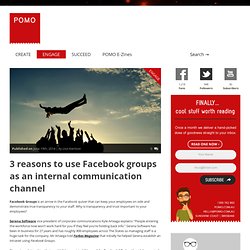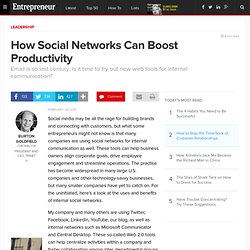

3 Smart Ways to Get Senior Execs Active on Internal Social Media. One of the most crucial and necessary parts of any initiative is to get leadership buy-in, and internal social media is no different.

However, is it enough to just get their buy-in without active involvement? Of course not! Senior execs’ participation in the internal social media lends it more credibility and improves employee adoption. Moreover, when employees have direct access to the execs, it helps improve employees’ engagement with the organization. While getting senior exec buy-in for implementing internal social media may be difficult at times, getting them on-board to participate on the social media can be even more challenging. So, how can Comms help them overcome these barriers?
#1. Help senior execs get comfortable with social media – help them understand what a blog is, what a discussion forum is, how to post comments, how to create videos, etc. Here’s an interesting anecdote shared by one of the members: #2. As one of the members rightly noted: #3. “Start small. POMO. Published on June 19th, 2014 | by Lisa Harrison.

How-social-networking-transforming-business-productivity-2. How Social Networks Can Boost Productivity. Social media may be all the rage for building brands and connecting with customers, but what some entrepreneurs might not know is that many companies are using social networks for internal communication as well.

These tools can help business owners align corporate goals, drive employee engagement and streamline operations. The practice has become widespread in many large U.S. companies and other technology-savvy businesses, but many smaller companies have yet to catch on. For the uninitiated, here's a look at the uses and benefits of internal social networks.
My company and many others are using Twitter, Facebook, LinkedIn, YouTube, our blog, as well as internal networks such as Microsoft Communicator and Central Desktop. Enhancing Internal Communication: The Missing Link - Social HubSite. Frustrated by traditional communication methods and their limitations when it comes to communicating with your employees?

Chances are your employees are too. While great tools exist – and have existed for years – that allow employees to share calendar events, send email and more. However, they are inherently limited. Due to the fact that these are generally associated with email accounts, they lack privacy and tools that make collaboration simple. But, there’s a solution. Cut Through the Clutter Traditional email services are great. For a business to be a success, it’s employees must be able to engage in ongoing communication. Why Use Enterprise Social Networks For Internal Communication? Facebook is working on fb work to expand into professional settings. Photo by John Moore/Getty Images If you've ever sneaked onto Facebook at work, it might be strange to think that the social network could be a legitimate part of your professional life.

But a report from TechCrunch indicates that that's exactly what's next. Except this version of Facebook won't be so distracting. TechCrunch spoke to a source inside Facebook who said, “We are making work more fun and efficient by building an at-work version of Facebook.” The project is apparently called “FB@Work,” and the source says it's being developed out of Facebook London. Other anonymous Facebook employees and engineers who had recently left seem to confirm the rumor, or report hearing similar ones. Another option would be for Facebook to essentially become a LinkedIn competitor with added functions like chat and groups. A major obstacle would be keeping people's personal and professional data separate. Why Whole Foods Is Using an Instagram-Like B2B App. Is there a market for a B2B version of Instagram?

Apparently, there is. FoKo, a 1-year-old photo-sharing app for businesses has snagged Whole Foods as a client. The supermarket chain began using FoKo earlier this year. Within 90 days, 1,000 employees in 12 regions were using it. The company hopes to glean insights from the photos that it can apply company-wide. The supermarket chain had experimented with Instagram, but found the public nature of the platform didn't meet its business goals. Eric Sauve, co-founder and CEO of FoKo, declined to say what Whole Foods is paying — if anything — to use the app. The hope is that FoKo will bring photo-sharing into the workplace. Have something to add to this story?
Enterprise Social Networks: The Next Big Thing in Internal Communication and Collaboration? Corporate internal communications, heavy on endless streams of emails and one-way messaging through intranets and newsletters, are among the last hold-outs in the social media revolution.

In our personal lives, we have adopted social media as a way of connecting with friends, families, classmates and people with similar interests. Email use, in turn, is declining. But at work, we cling to old forms of communication, particularly email. This, despite data from a McKinsey report that shows the average knowledge worker spends an estimated 28 percent of the workweek managing email. Even more disturbing: an estimated 20 percent of our work time is spent trying to track down information or colleagues to help with specific tasks.
Extensive List of over 40 e2.0 Micro-Blogging Case Studies and Resources. Micro-blogging is the social media buzzword that gets some serious mojo going for those of you passionate about social networking for the enterprise (myself included).

There are a plethora of tools available, and if you want a quick snapshot, you should read this CIO article on "12 Microblogging Tools to Consider. " In response to my previous post, "Extensive List of over 30 Enterprise 2.0 Case Studies and Resources," I had an overwhelming request for case studies specific to micro-blogging. So here it is. I hope you enjoy your new bedtime reading material. A Case Study of Micro-blogging in the Enterprise: Use, Value, and Related Issues [Jun Zhang, Researching Social Networks in the Business World]This is a case study about the early adoption and use of micro-blogging in a Fortune 500 company.
List of Case Studies by platform and then categorized by business need. Yammer Idea Generation Collaboration / Process Improvement Build Culture. 'Brands must grow out of internal comms infancy' Google's Social Network Goes Pro.
Blocking social media. Uses for internal social media. Policy / legal side of internal social media. Driving adoption of internal social media.